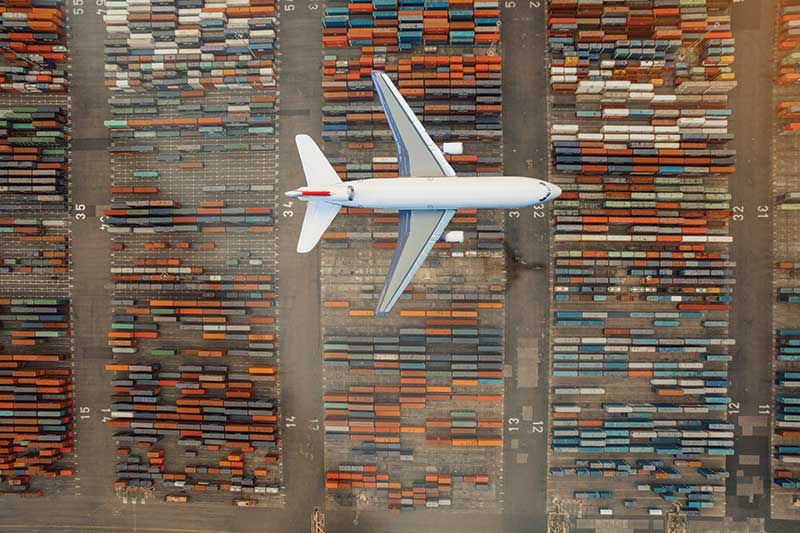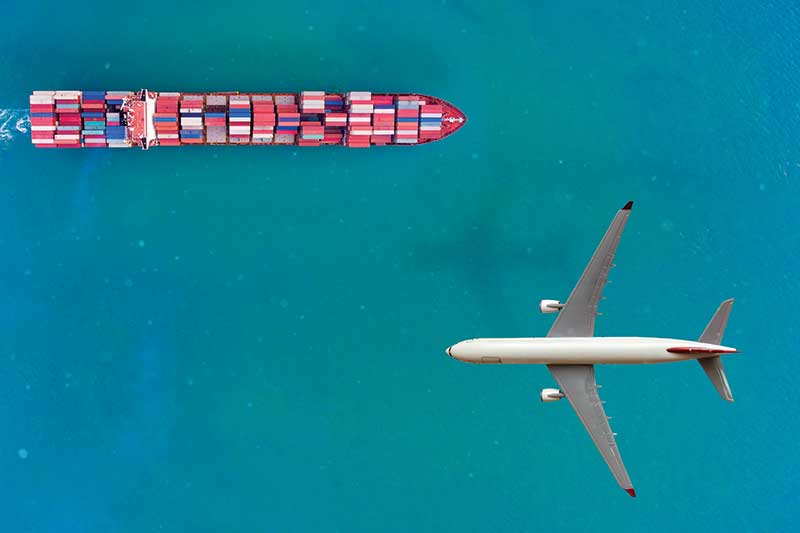Freight Forwarders: Technology as the key differentiator
Analysts expect the percentage of cargo booked and shipped through completely digital platforms to double to nearly 20% by 2024. To accommodate this rapid growth, large forwarders are investing heavily in digital offerings for booking, quoting, tracking, and invoicing—the ones who don’t will be left behind.
The pandemic had a major impact on freight forwarding. During its height, demand for goods escalated substantially, while shippers faced significant rate increases and unprecedented declines in capacity in air and ocean transport.
“The pandemic challenged forwarders’ ability to increase their access to capacity in line with surging customer demand,” says John Murnane, logistics sector lead for McKinsey’s Travel, Logistics and Infrastructure practice in North America.
The challenging period of time also uncovered vulnerabilities and a lack of resilience in global supply chains, conditions that exacerbated a shipper’s ability to know when their goods would arrive.
“Businesses were forced to operate under uncertain conditions and struggle to identify the most appropriate course of action,” recalls Viki Keckarovska, research manager and head of the freight forwarding team at Transport Intelligence (Ti). “The need to have an account representative to explain what’s happening and to help find a solution became even more pronounced.”
Spot market volumes also increased. “This trend started to emerge toward the middle of 2020 and has to do with the loose capacity and rising freight rates, which have been a feature of the global logistics market through 2020 and 2021,” Keckarovska says. “As markets upended and supply chain needs rapidly evolved, long-term contracts became less reliable.”
Large forwarders have increasingly secured dedicated capacity, particularly during the pandemic in air cargo markets. “During the pandemic, forwarders increased their chartering capacity,” says Murnane. “In addition, the share of spot bookings increased over the pandemic, as earlier block space agreements between airlines and freight forwarders were no longer fulfilled.”
However, dysfunction in the market opened unusual new opportunities for forwarders. Global forwarders saw unprecedented earnings increase. In fiscal year 2022, analysts estimate forwarders experienced EBIT margins in upwards of 10%.
This led to two significant outcomes: increased market consolidation as larger forwarders acquired smaller competitors and their block agreements; and accelerated customer adoption of digital offerings like booking, quoting, tracking, and invoicing. “Larger forwarders invested heavily in their digital programs and investors doubled the amount of funding in logistics startups between 2020 and 2021,” Murnane says.
Reality check
Today, market conditions have changed. Inflation, the threat of recession, high fuel prices, and decreasing demand have caused the industry to face a reality check.
Customers are more resilient in procuring logistics services. Meanwhile, trade wars and the need for sustainable supply chains are accelerating.
To remain competitive, forwarders are reassessing their supply chain operations and strategies. Some are providing more flexible capacity options and multi-modal solutions tailored to individual customer needs. Many, realizing that technology will continue to be an enabler, not a disruptor, see the need to adopt more technology and digitalization.
Analysts expect the percentage of cargo to be booked and shipped booked through completely digital platforms to double to nearly 20% by 2024. Big players such as DHL, K+N, DSV, UPS, FedEx and XPO have already introduced significant programs to develop scale, generate purchasing power with shipping lines and airlines, and capitalize on growth opportunities.
“This is especially the case within the e-commerce segment,” adds Keckarovska.
Forwarders respond
Technology is increasingly regarded as the key to the future success of forwarders.
“It will not be the big forwarders taking over the small forwarders in future; it will be the digitalized forwarders attacking the market with customer-friendly platforms that gain the business,” says Stephan Haltmayer, chief executive of forwarder Quick Cargo Services.
Iván Blanco Porras, CIO and VP BPO at DHL Global Forwarding, emphasizes how today, more than ever, technology is bringing new opportunities and new challenges. “Technology can help to improve productivity, gain and retain customers, improve traceability of the cargo and be more effective in our business in general,” he says.
Among technology’s key benefits, says Porras, are fast and reliable bookings, better visibility on what’s happening, smooth integrations, improved communication, and last but not least, more accurate information. Besides utilizing technology to achieve these goals, he adds that DHL Global Forwarding is working in information security to ensure its internal information and systems are as most protected as possible.
Many forwarders see freight technology as a critical component in global supply chains, especially during times of disruption.
“While the logistics market looks different today versus two years ago, shippers are still facing disruption in the market, including inland congestion, labor shortages, geopolitical changes, and sourcing challenges to name a few,” says Mike Short, president of global forwarding at C.H. Robinson.
Recent C.H. Robinson research finds that three quarters of its customers say those disruptions increased their need for technology, automation, and predictive analytics. For that reason, says Short, C.H. Robinson continues to focus on enhancements that help pinpoint market patterns, predict possible disruptions, and find ways to maximize efficiencies.

According to Short, the company has implemented a tech-plus strategy that serves customers by leveraging technology and innovation in addition to its people, scale and global suite of services. “This approach enables us not only to help our customers navigate today’s increasingly complex supply chains, but also orchestrate comprehensive, integrated strategies in a constantly changing environment,” he says.
In addition, the forwarder continues to invest in enhancing its proprietary platform, Navisphere, which was built by and for supply chain experts. “Our technology team is consistently innovating the platform to provide a tailored product for our customers and carriers’ needs, such as enhancements to our real-time visibility and pricing that allows competitive speed to market,” adds Short.
Technology is also at the core of DSV and its work with optimizing its customers’ supply chains. “The current challenges of the global economy only increase the importance of optimized supply chains as well as supply chain visibility and resilience, all of which are heavily dependent on digitalization and technology,” says Peter Matthiesen, senior director of group innovation at DSV.
Consequently, technology is essential to its strategy and internal operations. “Additionally, and just as importantly, technology is a lever to the green transition of DSV and the transport and logistics industry as a whole,” says Matthiesen “Therefore, we’re continuously and strategically testing and investing in innovation and new technologies that will create value to DSV, our customers and our ability to reduce the climate impact of our industry.”
The company is currently in an ongoing process of testing battery electrical trucks, replacing diesel trucks with battery-powered electric vehicles (BEVs) in many areas of its business. Ultimately, DSV’s ambition is to scale and implement the use of BEVs throughout its business. “We’re also looking into green hydrogen trucks and vehicles operating on other zero-emission fuels,” says Matthiesen.
Another technology that DSV is increasingly working on is artificial intelligence (AI), for instance in automating customer service with chatbots and improving data quality by collating data across systems and filling blanks.
CEVA Logistics is implementing sensors and GPS trackers to monitor the condition and location of goods in real-time, improving visibility, reducing losses and damages, and increasing customer satisfaction. However, Michael Rabaud, head of digital, data and innovation at CEVA, sees customer-facing applications as the emerging, visible part of the freight technology.
According to Rabaud, CEVA’s MyCEVA platform is designed to give customers greater control over their shipments from instant quoting and booking to real-time tracking and documentation. “It’s a multi-modal, multi-carrier platform for both imports and exports,” describes Rabaud.
The platform is also connected to CEVA’s global customer service tool Salesforce. This allows customers to receive assistance in their local language and time zone from their customer service contacts. According to Rabaud, other efforts include the continuing rollout of the CargoWise platform that’s expected to be deployed in 2025.
CEVA also continues to work on its partnership with Project 44 to provide global visibility solutions for ground and ocean shipments. “It’s a solution that’s directly integrated into the MyCEVA platform,” says Rabaud, who sees such platforms as strategic differentiators especially given the prominent role of e-commerce today and pressures customers experienced on their supply chains over the past few years.
“The discussion has moved away from a pure cost analysis toward a business enabler and a point of differentiation,” Rabaud adds. “Data will play a key role here, and we’re working on several initiatives using predictive algorithms and machine learning to address this new landscape.”













